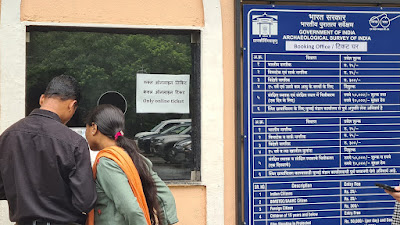Yesterday I visited the Aga Khan Palace in Pune, the place where M K Gandhi and his colleagues were kept after their early morning, surreptitious arrest by the British in 1942. The British apparently tried to keep the arrests under the wrap and spread a rumour that Mr. Gandhi went abroad. However, people soon found out where he was and anger spilled on the streets. The ‘Quit India’ movement, which was the primary reason for the arrests, gained even more momentum inspite of more arrests and brutal use of the police force by the colonisers. Gandhi and his colleagues were finally released in 1944, after about 21 months of imprisonment and the deaths of Mahadev Desai (the personal secretary of Mr. Gandhi) and Kasturba Gandhi.
There is a lot to that story, but much before that, I was greeted by a message pasted on the Ticket booths windows at the Aga Khan Palace. It read 'Only online ticket' in English, Hindi and Marathi.
I noticed visitors standing and busy with their phones. Two men were sitting inside one of the ticket booths; and a guard at the entrance, who checked the ticket before one could enter the space.
A few moments of
processing later a message appeared:
“System Upgrade in Progress to Enhance Your Banking Experience. Service Unavailable until Saturday, 13th July, 4.30 PM.
We Apologize for the
Inconvenience.”
I find it difficult to fathom the reasons that made ASI decide to go in for an online payment system. Is it not obvious that such a system prevents an entire Indian population who still do not have smart phones? And also those who may have a smart phone but may not always have an internet connection for various reasons, including its cost? As per the information issued by the I&B Ministry in 2022, only 600 million Indians (out of the 1.4 billion) owned a smart phone. I could not find the data for 2024, but even we assume there are 700 or even 800 million smart phone users, it leaves out at the very least about 600 million Indian citizens.
That basically amounts to
putting a needless barrier for some. In other words it turns into a needless
system of segregation and discrimination, even if that may not have been the
intention.
Parvez
(Photo credit: Parvez)
All rights for the Text and Photos are reserved with the author. For permission, please write to the author.
Sharing of the 'complete, un-edited write-up' is permitted only for educational and - or non-commercial purposes, with due credits to the author.






No comments:
Post a Comment